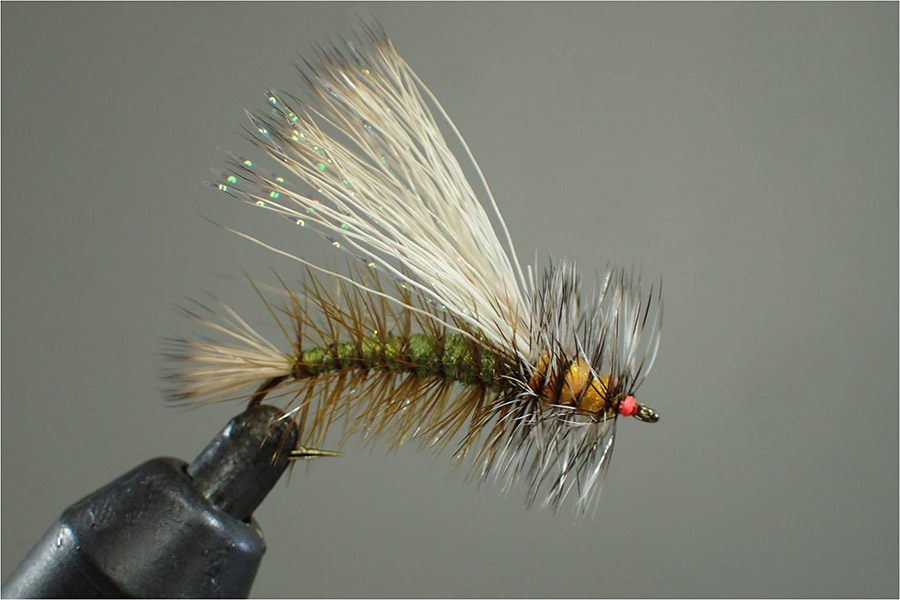Last week the drought that has gripped the Western Cape for many months finally broke. Winds blowing up to 50 kilometres an hour drove in sheets of slanting rain that fell for most of the night. And forecasts suggest more rain is on the way. Only the week before I had strolled up a tinder dry -side to a tiny mountain stream with a small box of dry flies, a spool of 8X tippet material and not much by way of hope. The stream was flowing tissue thin over dull-coloured, dusty pebbles, the water only just trickling over the tiny waterfalls.

Only just trickling over tiny waterfalls
Click in images to enlarge them
Small trout rose to the dry fly though, and I took a few of them, none big enough to get beyond the palm of my outstretched hand. There wasn't a sign of a decent-sized trout. I studied one particular glide for a long while. It's a place I know well and we nearly always spot two or three good fish here. After scanning the limpid water for a full 20 minutes I didn't see a single fish – well, not over four inches long.
But at least a few smaller trout survived the harsh conditions. So, as the year draws into winter when our rains are due, there is some hope yet for next season's fishing in this stream.
Worrying was that the week before, Robin Douglas told me he couldn't find any trout, not even small ones, on an upper beat of the Lourens River in Somerset West, though he did find serried ranks of simulid larvae, suggesting good enough water quality. We can just hope that after these recent rains the trout somehow make their way back up this lovely stream again.

The upper Lourens River in Somerset West

Simulid larvae in serried ranks...
From the scriptures...
I find good writing a joy, more so when it's about fly fishing. Here are a few fine examples from authors who will need no introduction:
James Babb on small stream trout fishing, taken from his wonderful book, Crosscurrents – A Fly Fisher's Progress:
Fly selection has become a science, but on small freestone streams it's still impressionist art...
But the skills learned on those little high-mountain streams have worked for me pretty much everywhere I've fished, while skills learned on classic waters don't transplant into mountain streams worth a dip of snuff...
Small stream fishing is trout fishing reduced to its essence. There's only you and the fish and they're a very critical audience...
Although some small streams can hold surprisingly large fish, they're more likely to average between six and eleven inches. If that sounds insignificant compared to a two-foot hog wrenched from the Big Hole, it is. That's the point. Being alone on a nameless stream isn't really about catching fish. It's about fishing...
( James R Babb. Crosscurrents. The Lyons Press. 1999)
And Nick Lyons on the subject of wild brook trout, taken from his delightful anthology, In Praise of Wild Trout:
On such jewel-like fish, no more than six or seven inches long, "the whole truth of our rural culture depends," claims Wetherell, calling the little fish "the quintessential New England creature." That's a lot of weight to put on its moss-mottled back. But beyond theories that such wild fish are the canaries in the coal mine, enough poets and fly fishers live with these trout in their brains that their salvation – and a certain stripe of ours – is worth exploring.
In Praise of Wild Trout. Edited by Nick Lyons. The Lyons Press. 1998.
Thomas McGuane on birds, from Tarpon Hunting, a chapter in his book The Longest Silence – A Life in Fly Fishing:
When you pass them, the mangroves empty themselves of cormorants; the birds drop down slapping the water with their wing tips, then shudder as though it had been a close call. The backcountry is full of pelicans, frigate birds, ospreys, bitterns, egrets, and herons, not to speak of the mass of small shorebirds, such as plovers, avocets, turnstones, surfbirds, and phalaropes, or a number of the glamorous "occasionals," as the bird books call them: ibises, eagles, and the utterly incredible roseate spoonbills, the colour of a Miami streetwalker's lipstick...
The Longest Silence. Thomas McGuane. Yellow Jersey Press. 2001
The Federation of Southern African Flyfishers (FOSAF) and trout in South Africa
FOSAF has tirelessly championed the cause of trout in southern Africa, no more so than over the last couple of years. In recognition of the work that this valiant organisation has done, and to give you a hint of where we now stand in this country with trout, I decided to quote from the latest Annual Report of Dr Bill Bainbridge, the Chairman of FOSAF's Environmental Committee:
'In anticipation of regulations that meet most requirements for the balanced approach that we have been advocating for a long time, we recently reviewed the FOSAF 2003 Policies and Objectives document. The balanced approach, which forms the core of the policies and objectives, both caters for the need to conserve indigenous aquatic biota on the one hand, while at the same time, catering for the needs of the trout industry on the other. This equates to the sustainable development concept, as advocated by the United Nations.
'In conclusion, the following quotation by de Moor and Bruton (1988) is included in this report, to illustrate the apparent return, after a great deal of debate, to some semblance of logic.
“Trout … are well established in the upper reaches of many South African river systems. An important recreational angling industry has developed around the two trout species, which also provides healthy recreation for a large number of people. Trout farming is also well established in South Africa and has the highest yield of any one species in the aquaculture industry (Safriel & Bruton, 1984). Clearly trout have a permanent place in the economy and ecology of South Africa. We must not, however, lose sight of the fact that they are alien fishes, and that it is our unique and primary responsibility to safeguard the future of our own indigenous fishes.”'
What is this 'semblance of logic' that Dr Bainbridge refers to? Well, the agreement is that whereas trout are alien in South Africa they will be regarded as not invasive where they already occur, but understandably, will be regarded as invasive where they presently do not occur.
Well done FOSAF! If you are not a member, I strongly urge you to join. See the FOSAF website http://www.fosaf.org.za for more detail.
Barry Ord Clarke's fly tying blog
Readers with a good memory will recall me writing in my last newsletter about sending a few pieces of klipspringer hair to Barry Ord Clarke in Norway. It turns out he's a pretty accomplished fly tier and here's some news from him:
'I have a fly tying blog that aims to get as many people as possible (6200 followers to date) to start fly tying, so if there is any way you can promote www.thefeatherbender.com I would be very grateful. It all helps.
'The klipspringer you sent me will be used in my new book on tying with deer hair, so I'll keep you updated on how it's going.

Barry Ord Clarke's rendition of the Kauffman Stimulator tied with klipspringer hair. (Photo per Ed Herbst).
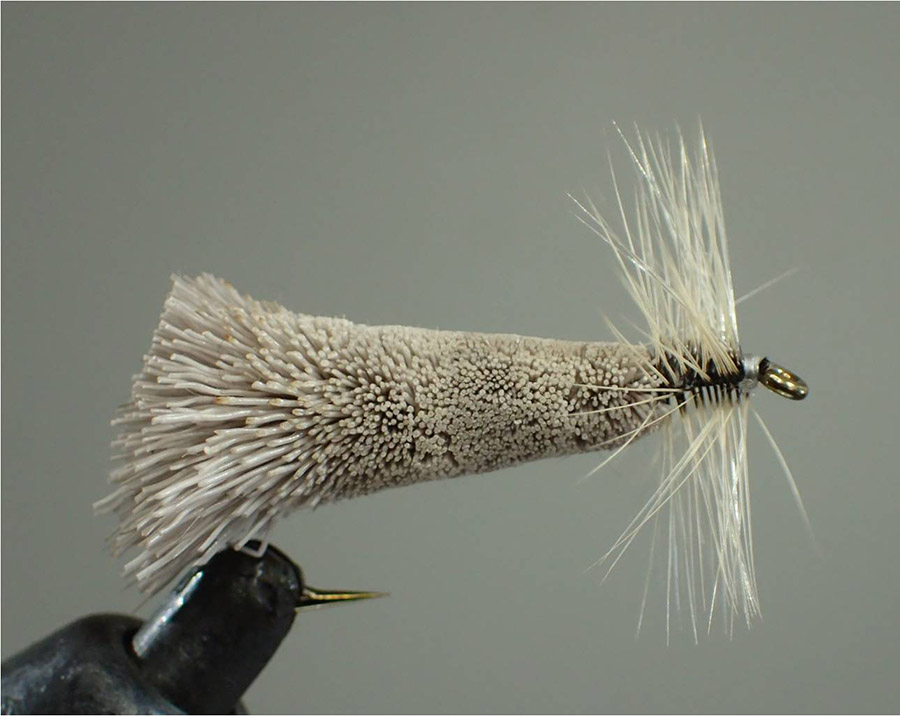
And Barry's Goddard Caddis, also tied with klipspringer hair. (Photo per Ed Herbst).
The South African Fly-Fishing and Fly-Tying Expo 2016
Says Gordon van der Spuy:
The South African Fly-Fishing and Fly-Tying Expo 2016 will take place on 30 July this year at Lourensford Wine Estate in the Western Cape. The event is being hosted by Boland and Western Province Fly Fishing in conjunction with Lourensford Wine Estate. This expo promises to be the largest of its kind in South Africa and although it will cater exclusively for fly fishers it will in fact appeal to any outdoor enthusiast.
For more information or to book a stand at the expo contact Gordon van der Spuy on This email address is being protected from spambots. You need JavaScript enabled to view it.">This email address is being protected from spambots. You need JavaScript enabled to view it. .
Images of the month from Ritchie Morris
Says Ritchie:
Mary-Jane and I have just spent a week in the Okavango and had a fantastic time with our photography.
We took the plunge and I got the new Canon 7D Mk II body, plus the new 100 – 400 mm lens. The upgraded body is wonderful – and the new 100 to 400 is out of this world. Pin sharp – even at 400 mm, and very fast focus. It is more useful than our 70 to 200 mm f/2.8 as it also has a close focal length. Here are some examples from the trip:

Duelling zebras in the mist

Leopard tortoise in colour
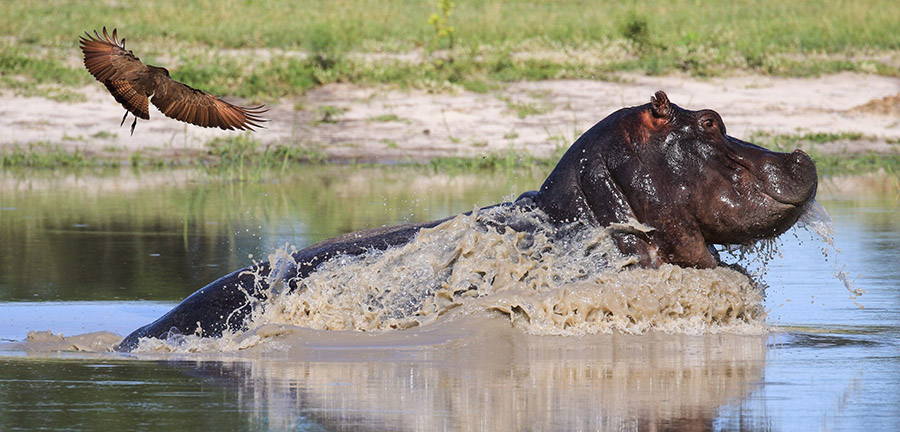
Surface-sipping hippo
(I wanted to know from Ritchie what fly that hippo rose to. Was he maybe fishing the ever-popular Floating Water Hyacinth pattern, or possibly an emerger, like the Budding Water Lily?)
Marcel Terblanche takes delivery of a new JVice – finished in red!
Ed Herbst writes:
A week ago Tom Sutcliffe and I drove to Franschoek to visit professional fly tyer, guide and artist, Marcel Terblanche.

Marcel's new JVice in red finish
He had just taken delivery of his new JVice, but had not had the opportunity to use it because he was preparing for a four day trip up the rugged Witels River early the next morning.
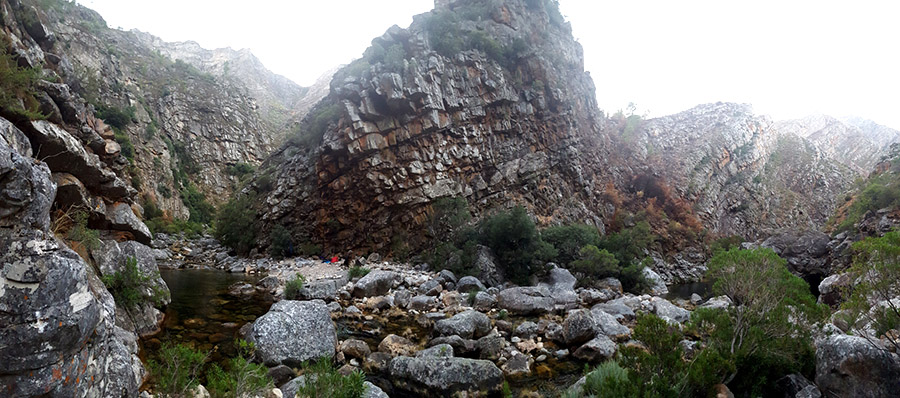
Daybreak on the Witels River where the Sunken Ant proved to be very effective. Photo Marcel Terblanche
Marcel and I are collaborating on a series of small flies which will seek to obviate the problem one has when one suffers from poor eyesight and shaky hands – threading a micropattern onto the tippet.
The prototype I took him is tied on a # 18 TMC 2488 fine wire hook which is 2 x short, 3x wide and has the shank length of a #20/22 but the gape of a #16.
This is a development of my sinking Copper Wire Ant (CWA) which is fished with a strike indicator.
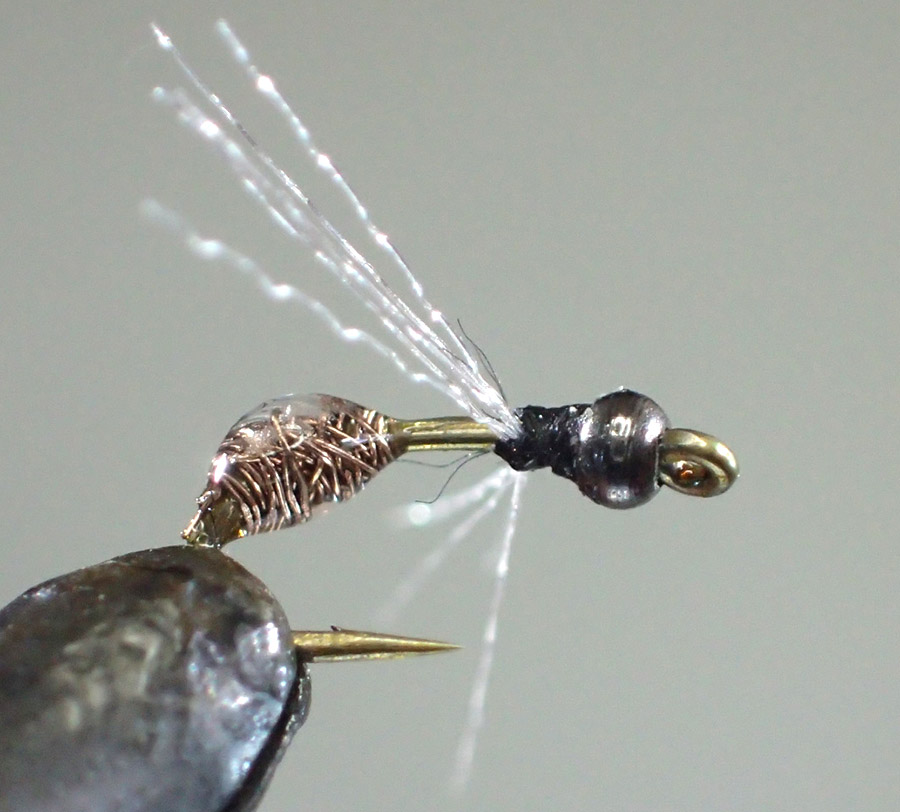
Ed's Copper Wire Ant which uses either a glass or brass/tungsten 1.5 mm bead
The wing is made of heavy satin organza which I got from a bridal shop in Cape Town’s CBD years ago. This conforms to Gary LaFontaine’s dictum that trout lying deep in fast water will rise more promptly to a wide fly. The spent wing design signals vulnerability and, as LaFontaine has pointed out, vulnerability trumps availability in trout feeding.
The design is very versatile because depending on water depth and current strength it can be tied with a glass bead or a 1.5mm brass or tungsten bead.
The copper wire is tied in an oval shape and then flattened with pliers to produce a flat oval which does not reduce the hook gape.
This is covered with two layers of UV light-cured resin to provide translucence and streamlining which increases the sink rate. The first layer utilises the new Loon Fluorescing UV Clear Fly Finish and the second layer is the thicker Deer Creek Diamond Fine UV Resin – the idea (in theory anyhow) being that the UV glow of the Loon resin would shine through the upper Deer Creek layer.
*
Marcel reported that the fishing on the Witels was dour with only four brown trout being caught in two days. Three of them were caught on the Copper Wire Ant, one of them a beauty of close to 20 inches.
Marcel took a photograph of the ants he found on the river bank alongside my Copper Wire Ant. A Google Images search quickly showed it to be Camponotus fulvopilosus’ which glories in the colloquial name of Bal-byter – a humorous reference to its alleged tendency to attack one’s nether regions. I will resist any suggestion that the CWA be re-named ‘Ed’s Bal-byter’.

Ed’s Bal-byter? Showing the remarkable resemblance between my Copper Wire Ant and Componotus fulvopilosus, a common streamside ant in the fynbos biome of the Western Cape
The micropatterns that Marcel will be tying will utilise the TMC 2488 and the heavier #18 TMC 2499 Spear Point barbless hooks, the Orvis Big Eye hook and the TMC 146Z. In the latter design the hook eye is open on one side but the wire has a flanged end which prevents the tippet knot from slipping out of the eye.

The TMC 146 Z hook design which makes it easy to attach small flies to fine tippets.
These hooks will lend themselves to small patterns such as the Sparse Brassie, Clyde Style Brassie and tiny versions of Neil Patterson’s Sunk Spinner. Patterson conceived the Sunk Spinner after getting refusals on a PT Nymph, even though the trout could be seen feeding hard a metre or so down. He realised they were taking drowned female Baetis mayflies that crawl below the surface to lay their eggs on the downstream side of submerged boulders.

Ed’s # 18 version of Neil Patterson’s Sunk Spinner tied on an Orvis Big Eye hook.
Rod and reel for sale
Andre Mellet has a brand new Redington 3# Classic trout rod 764 and a Redington Zero reel with 3# weight forward floating line. He's asking R4000. Interested parties can contact him on This email address is being protected from spambots. You need JavaScript enabled to view it.">This email address is being protected from spambots. You need JavaScript enabled to view it. or Tel: 0735608950.
American artist AD Maddox sent me some examples of her latest work...
AD Maddox was born in Nashville, Tennessee. She was raised in an artistic environment and has been painting for as long as she can remember. I have never met her, but we have been corresponding for years and I have one of her works of art.
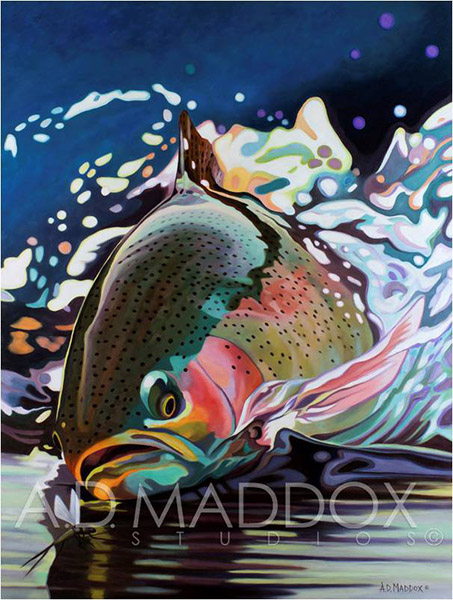

Clem Booth tries a new rod
In a note to me last week Clem said:
By chance I took delivery yesterday of an 8 and 1/2 foot 3 piece 4 weight cane rod by Edward Barder. I say "by chance" as it was not one that I'd ordered; a gentleman from Yorkshire had this rod delivered to him in 2012 (meaning he would have ordered it in 2010), took it out of leather tube and bag, and slipped it back again where it has since reposed. At some point, and for whatever reason, he decided never to fish it and instead asked Edward whether he could find another owner. Some people are nervous fishing Edward Barder's wands; they are finished like jewels and not much less in terms of financial outlay, but they needn't be molly-coddled. Edward's rods are magnificent fishing tools and are designed to be fished hard. They are literally as tough as old boot leather. Once a decade, I take my rods back for Edward for routine maintenance. A couple of weeks (more often months) later, you get the call and drive up to Newbury to be reunited with your family member (I kid you not, that's how special his wands are!)
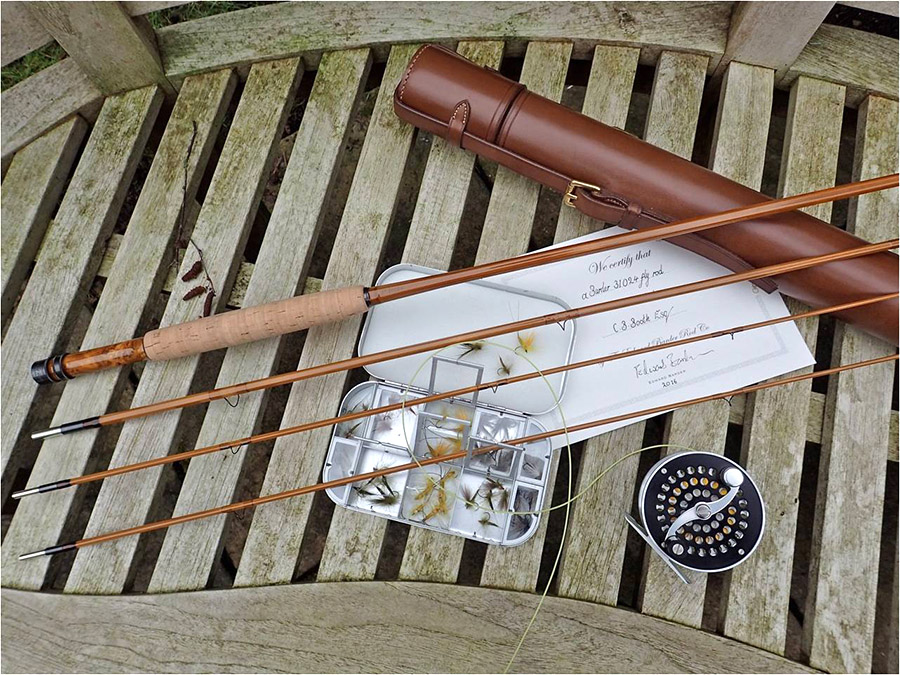
Barder No 31024
Whilst down in Cape Town recently, I received an e mail from Edward letting me know that this rod - serial number 31024 - was available. By the way, the 3 designates number of pieces, the 102 the length in inches and the 4 is line weight. I persuaded myself that this little gem needed a new home having waited four years to see the light of day on a stream. Would I not be performing an act of civic service by invited it to join the rest of the Barder family that I fish year in year out not only in the UK but around the world? I wrote the reply, pushed "send" and thus the commitment to love and cherish this 102 inch bamboo rod was made.

No 31024
Yesterday, I drove down the M4 motorway and not before picking up some pastries for our breakfast, I arrived at Edward's workshop which is located in an historic mill at the confluence of the Lambourn and Kennet, two of our many wonderful chalkstreams.
After polishing up the ferrules (you need to take good care of ferrules in the early stages, as Edward puts it, it's like running in a car), we assembled the rod, affixed a little Peerless reel and gave the rod its first ever airing on the stream behind the workshop, without a fly I hasten to add, being gentlemen ill-inclined to poaching (my fingers are crossed which is making typing tricky!). It was jaw-droppingly good! Those of us who fish cane know how smooth they are; occasionally, however, one comes across a cane rod which is simply sublime. Such a rod is this. I have (modesty forbids mentioning a number!) quite a few bamboo rods from a number of makers and this might be the sweetest action of them all.
Now, the season here only opens in April so we will need to wait awhile before giving 31024 a proper road test on a river, but all is not lost! At our little cottage in Ireland, there is a trout lake 30 meters from the front door and we are headed there for Easter! I will send you Part Two of this little saga after trying it out on this little lake which is home to some very substantial trout indeed. Part Three will be on the Loddon, a chalkstream in Hampshire not far from London, as I intend to fish it on opening day!
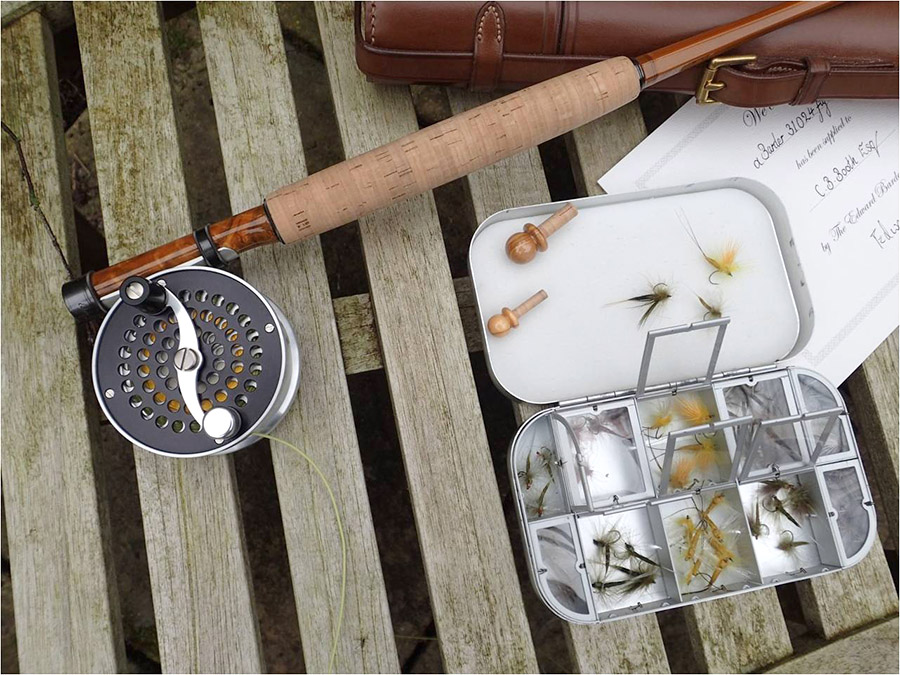
Barder No 31024, Peerless reel and Wheatly fly box with dry flies tied by Marcel Terblanche
By the way, all Barder's leather work is done by the lady who looks after the Queen's saddlery requirements! The fly box is complemented by beautiful mayflies tied for me by South African professional tier Marcel Terblanche. His work as a fly tier is sublime; he read up about the mayflies we find on my beloved Loddon and tied me up a fistful for spring! Apart from being a thoroughly good guy, Marcel will also make his mark in the fly tying community.
Sage 0-wt, Sage reel and fly line on charity auction
Despite extending the deadline in last month's newsletter, bids did not reach Clem Booth's reserve price, so sadly the rod has been withdrawn. Nevertheless, on behalf of all subscribers to this newsletter, I extend my thanks to Clem for a most generous offer.
Book Review
Pocket Guide: Insects of South Africa

This new pocket-sized guide compiled by Professors Charles Griffiths and Mick Picker covers both common and interesting insects, including their sub-aquatic forms, making it possible to identify a useful range of local species alongside rivers and streams.
431 insects are featured, each described with its key identification features, a colour photograph and distribution map.
An illustrated reference guide on the inside front and back covers makes it quick and easy to navigate to the right insect group. Very useful for fly fishers.
Published by Struik Nature. 2015. Price R150.
Myburgh van Zijl on one of the Western Cape's most spectacular trout streams
Says Myburgh:
Although fly fishing trips are few and far in between, I did manage a full four days on the Jan du Toit's River in January.
It's a special place, and I will treasure the experience.
I leave you with a few images from that weekend.
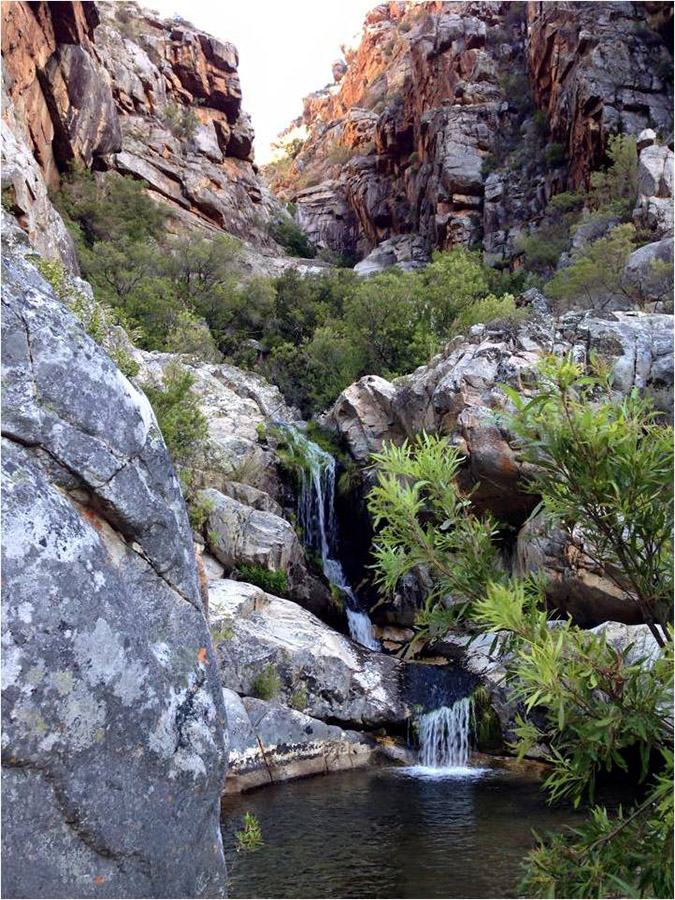


Parting shot – submitted by Paul Curtis, a fishing book publisher and friend living in Wales
Says Paul:
Here's a telling quote from Thomas McGuane...
The sport of angling used to be a genteel business, at least in the world of ideals, a world of ladies and gentlemen. These have been replaced by a new set of paradigmatic persons: the bum, the addict and the maniac. I’m afraid that this tells us much about the times we live in. The fisherman now is one who defies society, who rips lips, who drains the pool, who takes no prisoners; not to be confused with the sissy with the creel and the bamboo rod. Granted, he releases that which he catches; but in some cases, he strips the quarry of its perilous soul before tossing it back in the water. What was once a trout, cold, hard, spotted and beautiful, becomes "number seven."
To see Paul's fly fishing publications go to http://www.platannapress.co.za/about.html
Tom Sutcliffe

